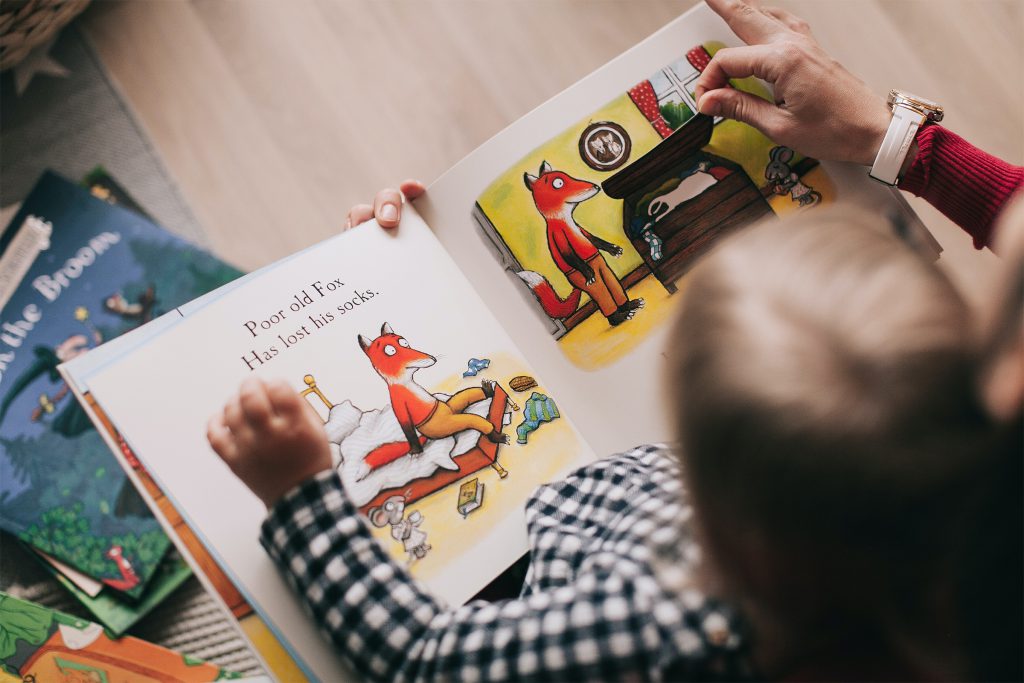Whether you’re learning how to illustrate your own children’s book or hiring a children’s book illustrator to do it for, it’s useful to be familiar with various illustrations styles common to children’s books, like cartoons and digital art, as well as different mediums for illustration such as freehand, watercolor, charcoal, etc. Knowing these concepts will help you better envision and decide on the right type of visuals for your story.
What Are Children’s Books Illustrations?
Children’s books illustrations are the visual images that accompany the text in children’s books. These usually depict key scenes in the story where the book moves along in it’s plot, usually through the experiences of the main character.
Children’s book illustrations bring the plot to life, complementing the words to help readers form clear pictures of the story in their minds. They can help promote visual thinking and improve the literary skills of young readers.
Illustration Styles for Children’s Books
Style is a broad term when it comes to art, and it’s often used interchangeably with the medium or technique in which the illustrations are created. But style refers mainly to the look or tone of the illustrations, which should be created to match the story and theme of the book.
Before even creating drafts of your visuals, you’ll need to decide on what style you’d like the images to be created in. This decision can help guide your artistic direction and ensure that you end up with cohesive illustrations. That said, don’t feel boxed into one kind of style. Depending on your book, it might make sense to mix multiple styles to convey the message better. These can include:
Cartoons
Cartoons bear similarities to real life but are portrayed in a more exaggerated way. They can be cutesy, wacky, or even over-the-top, and are typical in children’s books, especially for younger kids. Cartoons often come in multiple bold colors to provide a striking impression.
Realistic
Though children’s books rarely depict truly realistic images, some are more true-to-life in characterizations. You’ll often find these in books that are set in everyday situations or involve “real” characters. They’re also commonly used in children’s books with more serious, educational, or informative themes.
Whimsical
Whimsical or fantasy illustration styles take on more fun and dreamy effects; often they’re almost comical, and can inspire a more active imagination among readers.
Lines
Line drawings are outlines of forms and figures that aren’t typically colored in. They’re normally drawn in just one color (usually black, without any amount of shading), in a consistent line. You’ll find that line illustration styles are quite common in children’s books that double as coloring books.
Sketches
Sketches are rough drawings that don’t seem like finished work. They’re usually hand-drawn and are black-and-white, similar to the initial drafts of a piece of artwork, though some might look more “finished” than others. Although simple, sketches are often expressive and can be used to convey movement quite well.
Illustration Mediums for Children’s Books
Once you’ve chosen the illustration style that you want to apply to your children’s book, it’s time to decide what medium to create it in. This should depend on both the theme and the style of your book, as some mediums match different styles better. That said, you may also want to consider your own artistic abilities if you’re illustrating a children’s book on your own; but you’ll be limited to the mediums that you’re already good at working in.
Here are the usual illustration mediums for children’s books:
- Watercolor
- Acrylic
- Pencil
- Charcoal
- Collage
- Multimedia
- Digital Freehand
- Vector
What Makes a Good Children’s Book Illustration?
There are three main characteristics of good children’s book illustrations; They must be visually appealing, memorable, and relevant. They must be visually appealing to catch the eye of the reader and keep them drawn in. The illustrations must also be memorable so that they can be easily remembered (think Dr. Seuss). And finally, good children’s book illustrations should be relevant, not just in the context of the times, but in the context of the book itself. How the images change as the book progresses, must be consistent, and in rhythm with the story.
How to Illustrate a Children’s Book
Illustrating a children’s book is a straightforward process that follows a procedure similar to how a lot of artwork is made. It starts by finding the proper inspiration, then choosing a style and medium to work in, followed by creating rough drawings, then gathering feedback before creating the final images and layout of your book. Here’s a breakdown of these steps:
Find Inspiration
Look for inspiration from other children’s books or the works of other artists to figure out the type, look, and tone of the illustrations that you want to be added to your book.
Choose a Style and Medium
Commit to a specific illustration style and choose which medium you’d like to use to bring your vision to life. Make sure that both of these match the theme of your story, and are things that you can realistically create.
Perfect the Characters
Most children’s books revolve around a central character, and your illustrations must depict this figure consistently, even as the story takes different turns. Practice drawing your characters, making sure you get all their nuances, and applying them even when there are changes in scenes or expressions.
Create a Storyboard
A storyboard guides the general direction of your illustrations as they appear in your book. Making one can give you a better idea of the overall flow of your story and what images you’ll need at each scene, if any.
Gather Feedback
Once you’ve made rough drafts or perfected your characters, gather feedback to know if there’s anything you might still need to work on. It’s best to get insight from your potential readers, so find a few children to take a look at your drawings and ask them what they think.
Should I Hire a Children’s Book Illustrator?
Though it’s definitely possible to illustrate your own children’s book, hiring a professional illustrator is a good choice if you have the budget or believe that an expert hand can better visualize your ideas. You can find many children’s book illustrators online that offer their services as freelancers. Just make sure that you choose one that matches not just your artistic vision, but your work ethic, as well! From children’s book illustrators to Thinkorswim programmers, find the expert you need at Guru.



